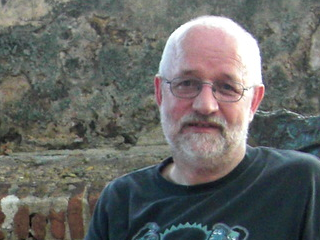- Document History
- Subscribe to RSS Feed
- Mark as New
- Mark as Read
- Bookmark
- Subscribe
- Printer Friendly Page
- Report to a Moderator
- Subscribe to RSS Feed
- Mark as New
- Mark as Read
- Bookmark
- Subscribe
- Printer Friendly Page
- Report to a Moderator

Name: Christian Altenbach
Home: Venice, CA
Programming Languages: LabVIEW, Fortran
Certification: CLD
Used LabVIEW Since: LabVIEW 4.0, (~1996)
Applications Areas:
We are doing basic research, mainly EPR spectroscopy and site directed spin labeling to investigate protein structure and molecular structural changes during function. One focus is the light receptor protein Rhodopsin. We have written many peer reviewed publications and reviews.
Biography:
In 1985, I received my PhD in Biophysics (Biozentrum, University of Basel, Switzerland) and then came to the US as a postdoc. The rest of my career was spent a research scientist in the Department of Ophthalmology at the Stein Eye Institute of the University of California, Los Angeles. After my retirement in 2021, I continue to work part time there. The lab has a joint appointment with the UCLA Department of Chemistry where I give an annual lecture on EPR spectroscopy.
In 1996 it became necessary to replace our old Nicolet 1280 computers that controlled the EPR spectrometers with a PC based solution. After attending a LabVIEW product demo, we got LabVIEW 4.0 and a few DAQ cards and I wrote the acquisition program while learning LabVIEW at the same time. Everything immediately worked as designed and these instruments were controlled for 20 years by the same old 120MHz Pentiums running the original applications built under LabVIEW 4.0. For reasons of hardware obsolence, the application was recently adapted to run on an sbRIO instead, still keeping most of the code and UI intact.
My computing background goes back to the early seventies with punch cards and Fortran IV. After becoming familiar with LabVIEW, I immediately saw the inherent power, elegance and beauty of graphical programming. Over the years many LabVIEW programs have been written, ranging from simple post processing, line shape simulation, time domain processing, network monitoring, 3D modeling, publication quality graphics, to complex Levenberg-Marquardt fitting of multicomponent line shapes with dozens of parameters. I have completely rewritten the Levenberg-Marquardt routines to allow global fitting of multiple multidimensional data sets and runtime selection of fitting parameters. Many of my programs take advantage of the inherent parallelism of LabVIEW and scale beautifully with the number of CPU cores. For example my spectral fitting program runs 30+x faster (~3000 spectra/second) on a high end 32 core Ryzen processor when allowed to use all cores At the same time it still runs perfectly on a very low end Atom N450 processor (~8 spectra/second). (.(full list of benchmarks ). For comparison, the calculation of a single spectrum took about a minute on our VAX11/780 in the late 1980'ies, even the spectrum display took a few seconds piped through a 9600baud serial port to the DEC VT240 terminal. How times have changed!
I use LabVIEW every day for any needed computing task and would never go back to text based programming.
User Groups:
I attend LVUGs at UCLA, but they have been rare in the last few years.
Discussion Groups:
Mostly NI discussion Forums. I am also a member of OpenG and LAVA.
Websites:
My public LabVIEW programs. (These are not of general interest)
My Google Scholar Profile (Contains most of my scientific publications)
NI Week Presentations:
- 2006: Jim Nagle, Christian Altenbach. Applied Curve fitting in LabVIEW.
- 2007: Jim Nagle, Christian Altenbach. Applied Curve fitting in LabVIEW.
- 2012: Christian Altenbach. Parallelizing the Unparallelizable.
- 2016: Christian Altenbach, Ed Dickens. Code Optimization and Benchmarking
- 2017: Christian Altenbach. Solving the inverse problem in LabVIEW
- 2018: Christian Altenbach. Tuning and detailing LabVIEW code for efficiency and beauty
- 2019: Christian Altenbach. From Variant Attributes to Sets and Maps (New in 2019)
Selected Publications (where LabVIEW is mentioned):
- Christian Altenbach, K. -J. Oh, R. Trabanino, K. Hideg and W. Hubbell. Estimation of inter-residue distances in spin labeled proteins at physiological temperatures: experimental strategies and practical limitations. Biochemistry. 2001 40:15471-15482.
- Christian Altenbach, Wojciech Froncisz, Roy Hemker, Hassane Mchaourab and Wayne L. Hubbell. Accessibility of Nitroxide Side Chains: Absolute Heisenberg exchange Rates from Power Saturation EPR. Biophys J. 2005 89:2103-2112.
- Christian Altenbach, Ana Karin Kusnetzow, Oliver Ernst, K. Peter Hofmann, Wayne L. Hubbell. High-resolution distance mapping in rhodopsin reveals the pattern of helix movement due to activation. Proc. Natl. Acad. Sci. 2008, 105:7439-7444
- Mark as Read
- Mark as New
- Bookmark
- Permalink
- Report to a Moderator
I recently became intrigued by the google scholar and h-index leaderboards. It's interesting to see a fellow LabVIEWer on it! 😁 Nice work.
Studying for CLA.
LabVIEW, inherit from social media habits!
- Mark as Read
- Mark as New
- Bookmark
- Permalink
- Report to a Moderator
Really cool!
thank you!
- Mark as Read
- Mark as New
- Bookmark
- Permalink
- Report to a Moderator
A very technical man !👍
